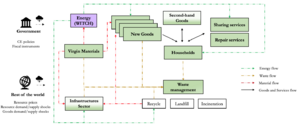CIRCEE
General Scope and Connection with Climate Mitigation
- Introduction
The decarbonization of our production processes and consumption of habits have a key role to play in achieving climate targets. One effective way to achieve this is by shifting from a linear economic system to a circular one, which emphasizes resource efficiency and reducing GreenHouse Gases emissions. The integration of circular economy poses many challenges to the IAM modeling community, including accounting for physical material flows, thermodynamics limits, and waste flows. CIRCEE (CIRCular Energy Economy), developed by the RFF-CMCC European Institute on Economics and the Environment, addresses these challenges by developing a stylized dynamic model. The stylized model will serve as a modeling starting point for the IAM community and will help mapping circular economy strategies into the existing climate scenarios.
- Model Scope.
CIRCEE is a stylized dynamic general equilibrium model that monitors physical material and waste stock/flows. It incorporates key industrial ecology principles to evaluate how circular economy strategies and enablers can decrease future greenhouse gas emissions and enhance resource efficiency, especially in resource-poor economies. The main focus of CIRCEE is on countries that may become relatively less reliant on resources in the the long run due to the adoption of circular economy strategies and new business models, such as the sharing economy and digitalization. CIRCEE can be shocked by many exogenous forces linked to circular economy strategies and enablers.
The CIRCEE model is a stylized dynamic general equilibrium model that monitors material and waste flows/stocks and incorporates key elements of industrial ecology. The model integrates is aimed to take a broad perspective of circular economy strategies and enablers. The economy is populated by 3 aggregated agents, namely the households, the sectors of production and the public authority. On the household side, 3 types of households differentiated by their low-carbon lifestyles and liquidity constraints are populating the economy. Households choose to consume different types of goods - non-durables, semi-durables, durable goods and second-hand goods - and different types of services - home-produced energy services, sharing (energy) services and repairing services. They make intra-temporal choices regarding the composition of their consumption good and services basket (e.g. consuming a sharing energy service rather than home-producing it) and inter-temporal choices from their savings and different types of assets (capital, durable and semi-durable goods, and second-hand goods). On the supply side of the economy, the economy is populated of 10 sectors producing the following products: primary (virgin) material, secondary (recycled) material, non-durable good, semi-durable good, durable good, capital good, sharing services, repairing services, second-hand (durable) good, and housing. All sectors, except the repairing and second-hand sectors, produce from labor, capital, energy (electricity and fuels), and materials (primary and secondary) inputs. The production structure of the economy is economically and physically consistent. It considers key thermodynamic limits, such as ruling-out the 100% recycling and repairing scenario, a minimal material balance condition, a thermodynamic efficiency condition, physical resources stock and flows, and volume-preserving CES functions. On the energy supply side, CIRCEE is soft linked to the IAM model WITCH from the RFF-CMCC European Institute on Economics and the Environment (EIEE) to assess the overall GHG mitigation potential of circular economy strategies. The public authority implements levies taxes, implements circular economy policies and makes public expenses. Finally, the model considers trade flows between the domestic economy and the rest of the world. The study of trade flows is important, as imports and exports of goods may have different material intensities.
The current geographical scope of CIRCEE is on Japan and South Korea. These countries are being studied first because they are among the least resource-rich economies in the OECD. Circular economy and new business models are essential for addressing climate change, improving resource security and promoting economic growth in these countries. While data availability will determine which additional OECD countries can be added to the model in the future, users may add other countries themselves, provided there is enough data to calibrate the model.
Users of CIRCEE can simulate the model for any desired number of years, using 2018 as the base year value, provided that the users have a clear trajectory or exogenous variables. Longer time horizon can also be run to avoid any end-of-horizon effect, but 2150 is generally sufficient. Results are usually reported for the period 2018-2100. The model has a yearly time step.
- Model documentation: in progress. Not yet available.
- Model development status
- Model source code (relative to milestone M24). The model uses the software platform Dynare (https://www.dynare.org). To run Dynare, the user needs either Matlab, Julia or GNU Octave.
Circular Economy Features
- R Words coverage and implemented in the model
CIRCEE provides a broad perspective on the economic and natural resource demand implications of a circular economy by integrating many different circular economy strategies.
- CE strategies and connexion with climate change mitigation
- Synergies and trade-off between the R word in the context of the stylized model
Insights for Analytical Framework
- Key mechanisms and interactions within CE strategies that lead to changes in GHG emissions.
- Tool exploration (demonstrating ideas before implementing them in large-scale quantitative models)
- Communication key CE dynamics (to the broader audience)
Refinement and Integration
- Explain the iterative process of refining the stylized models by incorporating results emerging from other models
- Discuss how the stylized models can be integrated into larger modeling efforts to assess the potential of CE in climate change mitigation more comprehensively.

